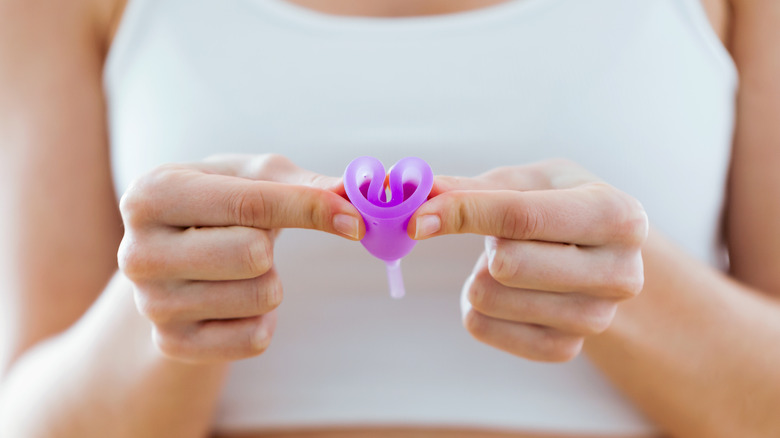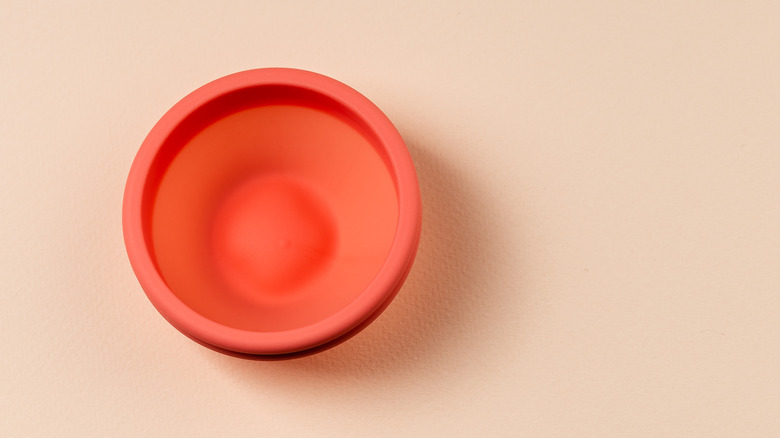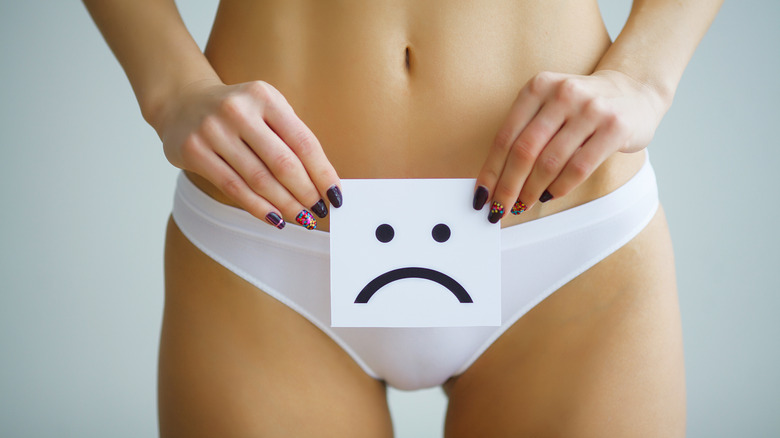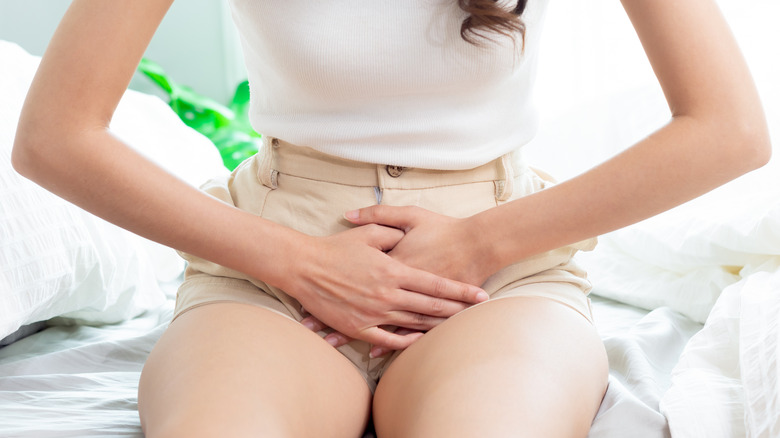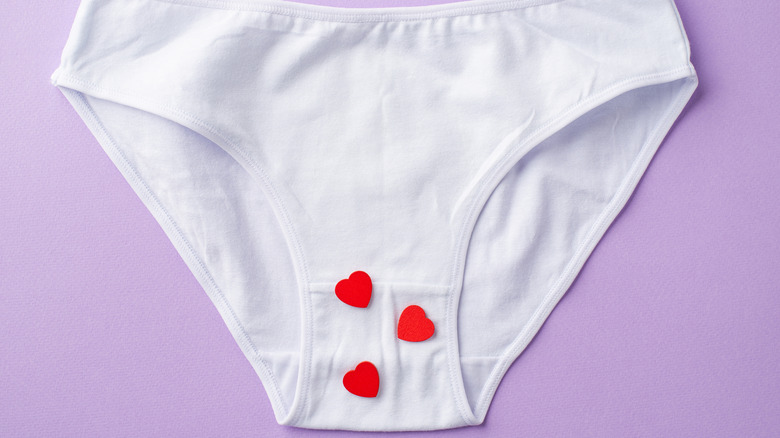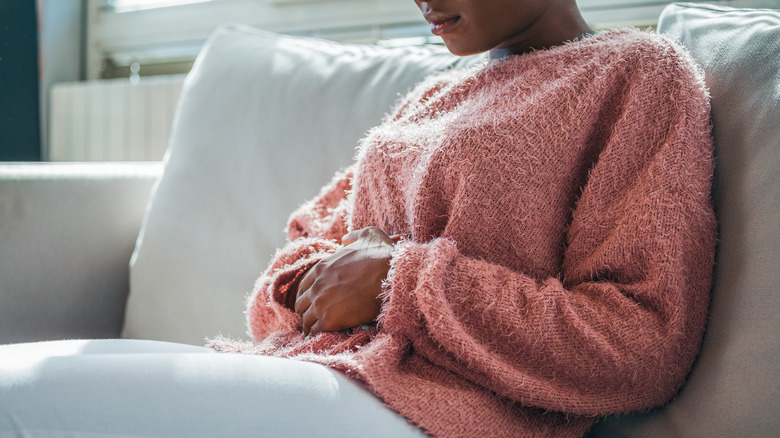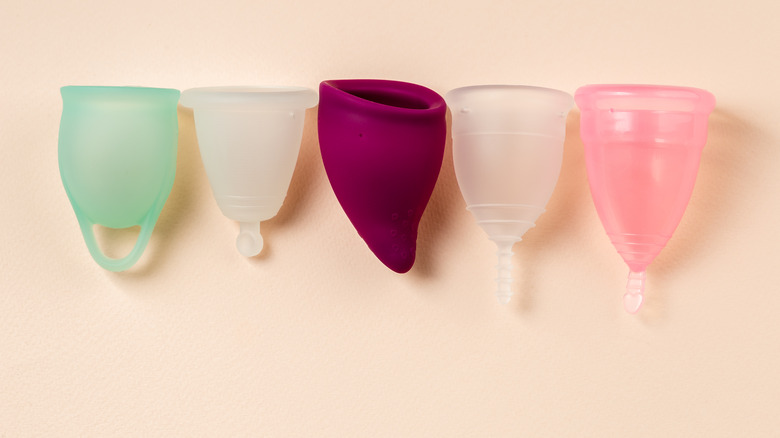Menstrual Cups: How Long To Leave Them In And What Happens If They Stay In Too Long
Are you obsessed with your menstrual cup? You're not alone. It seems more and more people with uteruses are enjoying the benefits of switching from disposable tampons and pads to the Diva cup.
For one, the small silicone insert that collects menstrual fluid is incredibly eco-friendly. In our current climate crisis, anything that stays out of a landfill, reduces waste, and can be reused, is a very good thing, and menstrual cups fit that bill to a T.
In 2021, The Washington Post spoke with Clarkson University professor Susan Powers about her research into the life cycle of menstrual cups. She asserted that the average person with a uterus would use around 240 tampons and pads in one year, whereas the cup, with its ten-year lifespan, only contributed to one-tenth of the overall manufacturing and disposal impact.
The cup is also a huge money saver. As of 2019, the cup averaged around $23. This may seem like a lot versus a box of tampons, but considering that it lasts for a decade, that price tag amounts to a mere 5% of what one might spend on a decade's worth of tampons or pads, per NPR.
But have you been wondering about their safety, how to use them properly, and how long you can wear them? To paraphrase the Bible, what happens if your cup runneth over? We investigate.
You can leave your menstrual cup in for up to 12 hours
At first glance, a menstrual cup can seem like a daunting task to insert. However, it turns out that they are no more complicated than the flick of the wrist. First, you fold up the silicone cup so that the bell shape of the cup can be inserted, insert it, and then give it a full 360 rotation so that it opens and forms a suction around the cervix, per NPR.
Easy-peasy, but with the ease of use and the lightweight design, it is conceivable that you might forget you're wearing it at all. That's what happened to one person, who wrote for Yahoo! Life that she accidentally left it in all weekend! Even that pales in comparison to a woman who revealed on Reddit that she left hers in for a full two weeks! She was fine, but it's probably not the best idea to insert and forget.
Ruby Cup, a brand of menstrual cup, wrote on its official website that the cup should be worn for a maximum of eight hours, although they note that it all depends on which stage you're at with your flow. On heavier days, you may need to empty it more frequently. Period Nirvana suggests using the cup for no longer than 12 hours.
TSS is rare but possible
With a tampon, there is always the risk of Toxic Shock Syndrome (TSS) if you leave it in too long. In 2015, a model's family sued the manufacturer of Kotex for improper warnings and labeling on their tampon boxes after she suffered a massive heart attack and the amputation of her leg due to TSS, per VICE. The outlet reports that TSS — which can be deadly — is typically caused by staph bacteria (or Staphylococcus aureus).
While more research is needed, the risk of TSS might be lower with a menstrual cup, and this may have to do with its design, as cups are not made of porous material like rayon. There is also no known negative effect on vaginal flora (aka the bacteria that lives inside the vagina) from the cup, per NPR. However, of all the thousands of users of menstrual cups, one study found that at least one woman's case of TSS was linked to wearing the menstrual cup. While that's worrying, the odds are still in your favor.
But it's still better to be safe than sorry, especially since leaving in your menstrual cup for too long can also put you at risk of other infections aside from TSS, warns Yahoo! Life. If necessary, set an alarm to take out your cup. To be on the safe side, check in with a healthcare provider if you accidentally leave your menstrual cup in for a few days, especially if you develop symptoms like pain, fever, and bad-smelling vaginal discharge. No matter how long you keep in your menstrual cup, contact a healthcare provider immediately if you develop signs of TSS, such as a sudden high fever.
They can smell
So, here's the thing: while leaving your menstrual cup in too long might not result in any health concerns, it may result in an unpleasant odor. One woman who accidentally left her cup in all weekend recalled, "Two-day-old period blood smells so foul (I had no idea!)" per Yahoo! Life.One of the reasons for that odor is that, after the recommended 12 hours, blood will start to decompose, per Enna Women, which will produce the smell. Another reason your cup might start to smell is using too much soap to clean it, or not rinsing the soap off completely, the outlet reports. Any soap left on the cup will interact with your vaginal flora, giving rise to odor.
"If you are worried about cup odour, wash it well with a mild soap and water and if the instructions say the cup can be cleaned in boiling water, do that too," gynecologist Vanessa Cullins from Planned Parenthood told Teen Vogue. If you're out and about during the day, you can also use menstrual cup wipes that fit easily into your purse or pocket for easy clean-up. This should be done often. To avoid infections and odor, boil the cup in hot water for the manufacturer's recommended amount of time before and after your period (i.e. when you're not using it!) to kill off any possible bacteria lingering. This may need to be done more frequently if an odor develops during your period.
They might leak
One of the great selling points of the menstrual cup is that it suctions close to the cervix, thereby catching all the blood and preventing leaks. A study published by The Lancet found that cups were just as effective as maxi pads or tampons at preventing leaks, something that Professor Chris Bobel, author of "The Managed Body: Developing Girls and Menstrual Health in the Global South" finds wonderful. "People don't want the embarrassment of having a menstrual stain on their clothes. Or the discomfort of it," Bobel told NPR.
But there are instances when your "cup runneth over," and when that happens, leaks happen. Juju reports that you might experience leaks if the cup begins to slip if you use too much lubricant to help with the insertion, or if you inserted it too low in the vagina. Gynecologist Adeeti Gupta told Self that another reason for leaks could be an improperly sized cup. If it's too small, try a larger size. And of course, you may leak if you leave your menstrual cup in for too long, which is another reason not to wear your cup for longer than recommended.
Nope, they won't suck out your cervix
While you may be nervous about inserting the menstrual cup, there's no reason to be. It isn't like the ghastly tools used in gynecology (speculums, am I right, folks?). There is currently no evidence that suggests the cup can suction out your cervix if left in too long. If you're feeling any pain associated with the cup, it's either due to using the wrong size, not using it properly, or just plain old tension. Relax!
Consultant gynecologist Nitu Bajekal told Cosmopolitan that it's "not possible" for a cup to suck out your cervix, telling the outlet, "The cervix is part of the uterus (neck of the womb) so it cannot be detached either in part or completely from the uterus except through a surgical operation, or very, very rarely because of a traumatic vaginal birth."
However, Dr. Bajekal warned, "If unnatural force is used because the cup has been perhaps left in too long and too close to the cervix, it is possible it will cause swelling and bruising of the cervix." In this case, you may need to see a healthcare provider to remove the cup, and the swelling and bruising should improve after a day or two.
How do you choose which cup to use?
Now that you're comfortable making the switch from tampons to a menstrual cup, it might seem daunting to choose the right one for you. There are so many brands. What's worse, there are so many different features and sizes. Low cervix cups, high cervix cups, empty stem cups — and an optional sunroof! Okay, we're kidding on that last one.
Luckily there is a definitive list on menstrual cups, ranked from best for first-time users, comfort, price, and ease of cleaning. Since 2016, The New York Times has tested 33 different cups from 21 manufacturers, and they've come up with a definitive list. The number one spot goes to the Cora Easy-Does-It cup, which they found to have the easiest insertion among newbies. Next was the MeLuna Classic because of its ease of use and ease of cleaning. Next came the MeLuna Shorty for those people with low cervixes. Taking the number four spot was old faithful, the famous Diva Cup, for those with high cervixes.
We hope this is of cervix to you! Ahem, we mean service.
